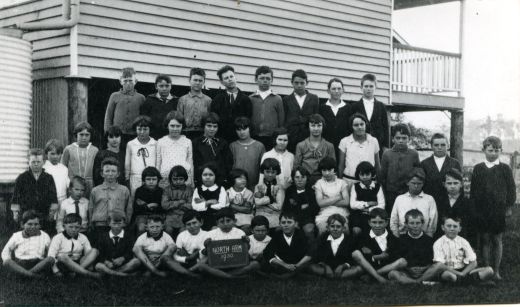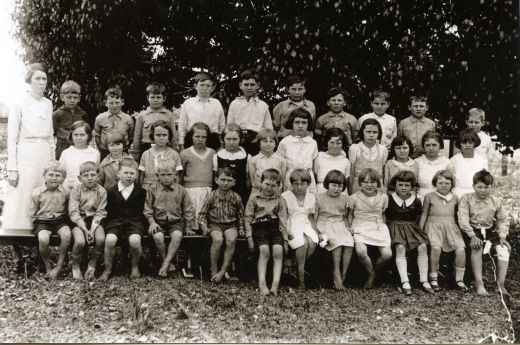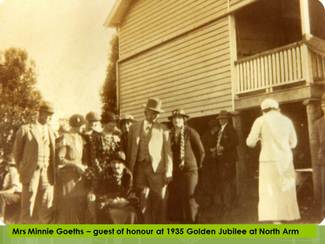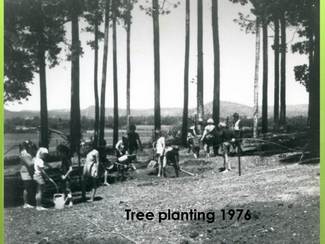1917
Notes from the P&C Minute Book
24 February 1917
The Dept. was asked to supply blinds for the front verandah which was being used as part of the classroom due to the numbers of children attending.
With a total of 35 on the roll and an average of 31 attending it was necessary to have one class on the verandah. Further correspondence was sent on 15 August 1917 regarding this as no action had been taken.
Every year a breaking up basket picnic was held on the last day of school. This was an important social event for the locals and most families attended in their entirety. Prizes were given and extensive time at meetings was devoted to how much money to spend ( or how much money was available) for prizes. Typically, prizes were given for attendance, good conduct, diligence and exercises.
1921
My School Days at North Arm 1921-1930 by Eileen Rowland ( nee Davison):
Happy memories: A kind, caring teacher, Miss Ethel Edwards, who taught me well for the first few years.
Wattle Day: When we all received little badges with Australia’s floral emblem, Golden Wattle, on it. We picked little sprays of wattle to pin with them off our lovely Golden Wattle trees.
Arbor Day: A look at the school grounds will show what that day meant to us. So many of us wanted to plant a tree we planted the camphor laurels too close. Conservationists aren’t a new breed.
Fancy Dress Ball: We had a fancy dress ball in the North Arm Hall every year, where we learned to dance.
Bad memories: That Bogey Man, the School Inspector, who would get off the morning train and sneak in on us. Teacher dreaded him as much as we did but usually got a good report.
1923
1924
Teachers: M E Scott, Douglas Kirk, Les Cutler ( 1924-1928)
While schools in the surrounding districts were closing down due to lack of attendance, facilities at North Arm School were by 1924 being taxed to the limit. Enrolments reached over sixty in that year – all held in one 21ft by 14 ft room with use of verandahs on fine days only.
(Today that original room now houses the staff room for the school.)
1925
Teachers: F Leembrugger, Maude Grealey ( 1925-1927)
School life at North Arm 1925-1930 : Anne McCord remembers… Children did not have the advantage of school buses in those times . Pupils either walked ( sometimes walking more than 3 miles) or rode horses. A horse paddock was provided at the school and pupils had the task of catching and saddling their mounts when the day’s schooling was over. Sometimes the mounts did not co-operate!.
The North Arm of the Maroochy River was a major hazard. The bridge was low and rainfall seemed plentiful and the river had a habit of rising quickly. During the wet season the teacher had to keep sending a senior boy down to the bridge to keep checking on the river height as the children from North Arm side of the river had to be sent home before the bridge was flooded. If the water rose too quickly for the children’s safe crossing, they had to walk through paddocks to Benn’s property ( now Carruthers) where there was a higher bridge. Then it was a case of walking by the railway line to North Arm.
When the school had two teachers, the assistant used to board with a family at Fairhill and the Head Teacher lived in a Department house provided at North Arm. This was situated behind Partington’s present home. In wet weather when the river was over the bridge for days on end, the assistant teacher conducted school at the school itself, for children living on that side of the river, and the Head Teacher held school in the North Arm School of Arts for all who lived on the North Arm side of the river. School reading books, slates, pencils etc. were stored permanently on the North Arm side for use in the hall. So no more holidays because “the river was over the bridge”.
North Arm itself was quite a town in the gold mining era. It boasted a butcher’s shop, a bank, a post office attached to a general store, another general store known as Flint’s Store and situated adjacent to where Conlans now live.
There was a huge bunya pine tree close beside it and children loved to collect the bunya nuts which fell in abundance from this huge tree.
The building which became McDonald’s baker shop, was in the days of the mine, a flourishing café.
Russell’s sawmill was quite a large concern too.
Gold Creek area produced an abundance of bananas. Mr Geoff Adams employed a large number of men and weekly transported about 400 cases ( large wooden) from his plantation at Gold Creek to North Arm Railway Station. The transportation was done on a bullock wagon drawn by at team of bullocks.
Dairying was also an important industry and it was not uncommon to see the dairy farmer transporting his can of cream in front of him as he rode his horse to a “pick-up point”. The cream carrier then collected the cans and took them to the butter factory. On his homeward run the cream carrier brought out each family’s requirements of bread and meat and also their mail.
Visits to the beach were very rare. If one wished to go to Coolum, it was a case of walk to the railway station, board a train, then after getting off the train, one boarded an open-sided cane train with wooden seats and chugged along on this down to Coolum.
Gympie was the nearest State High School and those children who qualified for a secondary education first had to pass a qualifying examination, and then board either in Gympie or Brisbane while studying. This meant leaving home at the age of about 12 years.
Teachers I remember at North Arm during this period were: Mr Cutler, Miss Shanks, Miss Grealey and Mr Campbell.
All four were hard-working, dedicated teachers. Mr Cutler later became an Inspector of Schools. “
1926
Henry Krome recalls: “ I am Henry Krome. My parents were farmers on Gold Creek Road. I started school at Browns Creek and later went to North Arm State School.
In approximately 1926, all of the ridges from about four miles out from North Arm on the Gold Creek Road were growing bananas. The biggest grower was Mr Geoff Adams. At one time approximately eighty odd men worked on his plantation. I could still show you today a spot that was called Workman’s Entrance.
The bananas were packed in bushel and a half cases to be sent to the southern markets.
The cases were cut from timber on the farm at a sawmill owned by Mr Adams. The logs were taken to the sawmill by bullock wagon about seventy cases at a time. Mr Adams used three bullock teams at that time and some were used for carting timber to North Arm, which had a big sawmill at the time.
When a patch of bananas was finished, the ground was planted in paspalum and Rhodes grass and later the area became dairy farming. Cream was taken into North Arm and sent by rail to Caboolture. I can remember my old brother, Eric, taking a can of cream on the pummel of the saddle when he was riding his horse to school at North Arm.
I also rode a horse to school at North Arm and one morning I had about three children on behind me. Between the Hall and Davison Bridge I went into the creek to give the horse a drink and when we went up the bank to the other side, Bil Darwin, the last of the three on the back, went straight over the horse’s tail into the creek.This was a funny horse because sometimes he would open the kids’ bags and eat their lunches”.
1927
Teachers: Gladys Shanks ( 1927-1929),
Project Clubs were set up in Primary Schools from 1923. Accounts of a successful Pig Club are on record for 1927 at North Arm, and other Project Clubs, such as Vegetable Gardens, Calf and Cane Clubs proved popular. The motto of the Project Clubs is “Do to Learn.”
My School Days at North Arm 1921-1930 by Eileen Rowland ( nee Davison): The Pig and Calf Club Day, when a supervisor from the Department, on presenting my brother and I with prizes for Best Pigs, said he wasn’t surprised to see us win as we came from a good ‘pig family’ the Davisons. Somehow my medal with the pig engraved on it means more to me now after 57 years than it did then.”
1928
Teachers: Melrose Campbell ( 1928-1929)
North Arm School memories by Joan Tobin ( nee Best): My memories of the North Arm State School are very happy ones. I received all my primary education there and attended from 1928 t0 1935. The school consisted of two rooms then, with a lady teacher for the “little kids” and a male teacher for the older children. In my times, the boys far outnumbered the girls. We used to play rounders in the lunch hour and my great failing was that I always ” hit up a catcher”. How the boys used to scold me! I was never welcome on either side. I lived on the school side of the river and how we envied those on the town side in the rainy season. We never failed to have a wet season every year in those days. The river would flood, the bridge would go under and the North Arm people couldn’t get to school. Still I don’t suppose it was too bad, we did a lot of drawing on rainy days. It didn’t do much for me, I still can’t draw.
1930
Teachers; Neville Herbert ( 1930-1934), Ruby Dunne ( 1930-1934)
North Arm School memories by Joan Tobin ( nee Best): Do my friends of those years remember Mr Herbert and how fond he was of poetry? I still remember the poems taught to us by him. Can you remember when we would stand around the room and recite “Daffodils”? He would always have his little joke and say “Who has got sore eyes?” when we came to “10,000 saw I at a glance”.

1934
Teachers: Tom Fleming (1934), Alf Collins ( 1934-1939)
Tom Fleming remembers his stint as head teacher around North Arm in 1934: Accommodation was hard to obtain for a teacher at North Arm, so for a couple of months, I had to stay at O’Reilly’s Hotel in Eumundi and commute by train each morning to the North Arm railway station. From here I had to walk to the school, which distance I can recall was a mile or two along an old bush road, which was very slippery in wet weather. There was no suitable train for me to return to Eumundi on at the end of the day, so I was forced to walk to Eumundi each afternoon.
However, I found very suitable board for the second half of my stay there with Mr and Mrs George Best, whose home was near the railway siding named Bridges. Mrs Best had four daughters only one of whom, the youngest was still at home. The Bests welcomed me as a son, and proceeded to take me under their wings and to lavish me with their extreme hospitality. I well remember Kit’s culinary prowess, particularly the excellent cakes she was able to produce in the most fantastic shapes of sailing boats etc.
On Arbor and Breaking Up Days she found time to make one for each boy and girl in the school – about sixty in all. The Hall family lived next door and many a good time we all had together with the simple pleasures of country living.
Indeed friendships with both families lasted for many years after I left North Arm, and memory of Kit and “Geebo” particularly lingers with me still.
The school consisted of two classrooms and a Miss Ruby Dunne was my assistant. She was replaced in my time by Miss Flo Glennie, who also boarded with the Bests. In flood time, she and I had to cross the creek to get to school, and many a time, I carried her on my back across the swollen stream.
I returned on most weekends to Gympie, so that I didn’t get to know many of the parents socially. But I do remember staying back for some of the local dances, dancing being a pastime I enjoyed muchly in those days. Whenever my wife and I pass through Yandina, I point among the trees to where I think the school stood nearly fifty years ago and I recount a few of my memories in that locality in the “good old days”.
North Arm School memories by Joan Tobin ( nee Best): When Mr Fleming followed Mr Herbert we became great singers. Mr Fleming loved music and taught us to sing in two part harmony. No piano in those days, just good old turning fork. One day we were singing “London’s burning” with great gusto and when we came to “Fire, Fire”, we put such feeling into it that Mrs George Davison heard us from half a mile away and said “Dad, do something, the school’s on fire.
Mr Collins came after Mr Fleming and that was when the residence was built for the Head Teacher.
Do children still ride horses to school, I wonder. Many did in those days and the horses would be put in the horse paddock at school. After school some of them never wanted to be caught, and we would all have to save a bit of bread from our lunch and coax the horses to come to us with the bread.
I remember Arbor Day when we would plant trees and Wattle Day when we would wear a spray of wattle. None of us were too keen about the visits of the school nurses and school dentist.
In between all these activities we did quite a bit of school work and I am grateful for all the dedicated teachers who gave us a very happy childhood, well supported by our parents and taught us what matters is to “play the game”.

1935
In 1935, fifty years of schooling in the North Arm district was celebrated at the jubilee anniversary of the old Fairhill School. This occasion marked the first twenty years at the new North Arm State School. Honoured guests included Mrs M Goeths ( who was then 87 years of age) and her two sons who had helped their father to construct the old slab hut which served as the original school room.
Of the fourteen original pupils enrolled on the first day at Fairhill School , seven were present to answer the roll at the Jubilee Celebrations.

1936
Teachers: A Sanderson 1936, L Forde-Jones ( 1936-1937)
1937
Teachers: Grace Webster ( 1937-1938)
1938
Teachers: Alf Collins
By far the most enduring contribution to the school of any of the Project Clubs must be that of the North Arm Experimental Forestry Club. It was commenced on 24th February 1938. Foundation members were : Joyce Collins, Muriel ( Jean) Hockey, Merl Dellit, Barrison Gordon, Maurice O’Brien, Allan Bishop, Daphne Collins, Joan Worthington, Dorothy Winkle, Mary Wegner, Mary Taege, Greta Clark, Reginald Bishop, Arthur Sinnamon and Ronald Bell.
On 10 November 1938, forty Kauri Pine trees were sent from Imbil Forestry, of which thirty-six were planted out.
1939
Teachers: Henry Grant ( 1939-1940), W Tucker ( 1939)
1941
Teachers: Kenneth Phillips (1941-1946),
World War 11 and the threat of Japanese invasion led to temporary suspension of compulsory school attendance at coastal schools. Only the schools
1946
Teachers: James Walsh ( 1946-1950)
1951
Teachers: John O’Keefe ( 1951-1954)
1954
Teachers: John Trehearn ( 1954-1958)
A report in the Nambour Chronicle on 20 February 1954, tells of a “rampaging 80 mile an hour cyclone which lifted the North Arm School of Arts from its stumps, and in a matter of seconds crashed it to the ground – a heap of wreckage”.
The hall which was church, Sunday School, dance hall and school hall to the people of North Arm for more than a generation was destroyed.
In true community style, the people of North Arm decided to rebuild. Fundraising was boosted by a Courier Mail Flood Relief Fund donation of two hundred and fifty pounds. The people of North Arm gave three weeks of their time to completely rebuild the hall and what a celebration it was that marked the opening of the new hall.
The newspaper of the day reports: “All day more than three hundred men, women and children ran foot races, rode in a gymkhana, threw brooms, pushed barrows, and competed in a terrific programme of open-air events. At dusk many families rushed home to milk cows. At night they were back for the official opening dance. And outside the gay new hall was the biggest collection of cars and trucks in North Arm’s history.”

1958
Teachers: Alfred Moore (1958-1962)
1959
1960
Teachers: Kajewski ( 1960)
1962
Teachers: Wallace Chin ( 1962-1963)
1963
Teachers: Donald Turnbull ( 1963-1967), Miss Mayell ( 1963)
1965
Another big day in North Arm’s history was the Golden Jubilee celebration for the North Arm State School, in September 1965, to mark fifty years of schooling at the new school.
Thirteen of the first-day pupils ( who numbered eighteen in all) were still living, and the following pupils answered the roll call: Mrs Murray ( Emily Davidson), Jim Davison, Harry Davison, Mrs McFadden ( Agnes Hall), Mrs Cox ( Chrissie Hall), James Hall, John Hall, George Ham, Harry Ham, Mrs Cavanagh ( Ruby Morgan), Tom Wegner, Alf Worthington and George Worthington.
Absent were John Davison, Reta Morgan, Gordon Russell , Magdeline Smales, and Phyllis Ward.
Mrs Loimaranta ( nee Kotkamaa), the first North Arm teacher in 1915 was guest of honour.
1967
Teachers: Arthur Young ( 1967-1969),
By 1967, the school was in danger of closing because of a fall off in numbers. There were only 36 on the roll for the entire school in that year and worse was still to come. When new families were settling in the district primary aged children were welcomed with open arms. Parents were continually asked “ How many children do you have and will you send them to North Arm?’ The school was literally prevented from closing by a few families with four or more children in the late 1960s.
1969
Teachers: Wilfred Bunney ( 1969-1970)
1971
Teachers: Barry Struber ( 1971-1975)
In 1971 there were no new enrolments at all and grade one enrolments were barely keeping pace with grade seven’s going out to high school . Enrolments were at an all time low of only sixteen pupils.
1974
In 1974, four more children came from two families settling on new subdivisions and five grade one enrolments made things look brighter. More farmland was being cut into acreages during the early 1970s and families were settling, so school enrolments were at last increasing again.
In April 1974, with 24 on the roll, a library aide was employed for the first time. This was a Mrs Bennie who stayed for ten years.
1975

1976
Teachers: Kevin Bosel ( 1976), Joanne Smith ( 1976)
In 1976, the numbers were over 31, and the year commenced with two teachers for the first time n many years. By the years end there were 48 children .
Other improvements in 1976 saw the third classroom underway, new septic toilets were opened in September, and the office and classroom were moved from Pomona School.
1976 saw the Ladies Auxiliary have their biggest catering morning ever, when the Queensland National Tour for Veteran, Vintage and Classic Cars was held, and over 320 entrants visited the school . This is still the largest rally of vintage and classic cars ever held in Queensland. What an enormous task for only about 30 families attending the school to put on Devonshire teas for the occasion – but they rose to it.
1977
Teachers: Neville R Smith ( Principal 1977-1978), Margaret Robertson ( 1977-1980), Patricia McCullough ( 1977)
“ North Arm School would have to be set in one of the most beautiful parts of our state. Those were my thoughts upon my arrival at the school in January of 1977. Things were a little difficult at first, the school had grown suddenly and there was not enough room. My assistant teachers taught in the two classrooms and I taught under the school until another room was added. We managed quite well under the circumstances. “
The new school room was ready in 1977 when numbers had increased to more than 60. A third teacher came for the last term in 1977.
The tuckshop was built under one building, and to make more teaching space, the library was moved into a cramped store room. This was a busy year with expansion in many directions.
A school bus run began from the Browns Creek area; an adventure playground was built, and the tennis court bitumen surfaced. Most of the work was accomplished by the P&C with subsidies from the Education Department.
1978
Teachers: Alison Adams ( 1978-1979)
In 1978 a double demountable classroom was moved in, which meant that the library went back upstairs and more space was enjoyed by all. There was now room for a TV and activities room, and classes under the school were no more.
In 1978 Community Outreach Week was celebrated at the school with displays from the TAFE classes, and community members gave demonstrations to the children and interested parents of silversmithing, leatherwork and painting. The children all made their own macramé hanging baskets .
The children took part in their first camp at Sunday Creek in 1978.
1979
Teachers: Helen MacInnes ( 1979-1980), Dianne Buckton ( 1979), Peter Blundell ( 1979-1980)
The pre-school began in 1979 and a fourth teacher joined the staff. Enrolments touched 80 and have remained in the eighties ever since, with approximately 55 families.
( This was written in 1985 and enrolments at the school have continued to increase)
In 1979 camps were held at Bunya Mountains and Toowoomba.
1980
Teachers: Merv Carr ( 1980), Jan Kelly ( 1980-1982)
In 1980 the preschool was able to occupy its own modular building. TAFE classes were held at night in the school rooms during 1977, 1978 and 1979. Community members came to pottery, painting, leatherwork, macramé, tapestry, crocheting, photography, basic mechanics and horticulture classes.
1981
Teachers: Hugh Davis ( 1981-1983), Ken Rosen ( 1981), Karen Beckman ( 1981-1983), Gail Davies (1981-1984)
1982
Teachers: Janet Shaw ( 1982), June Morrish ( 1982),
1983
Teachers: Ted Toohey ( 1983), Lorraine Quinn ( 1983), Julie Dickson ( 1983),
The highlights of 1983 were the acquisition of the ground for an oval, and the meeting of Prince Charles and Lady Diana at the Yandina Ginger Factory. Many children and their teachers were able to speak to and shake hands with the royal couple.
1984
Teachers: Bernie O’Brien ( 1984), Helen Farmer ( 1984), Julie Ainscough( 1984), Wayne Torrens ( 1984)
1985
In September 1985, the Centenary of Education in Queensland was celebrated with maypole dancing, displays and lots of fun. Mrs Loimaranta was again guest of honour.